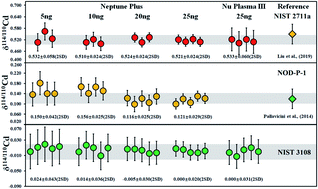High-sensitivity determination of Cd isotopes in low-Cd geological samples by double spike MC-ICP-MS†
Abstract
With new advancements in MC-ICP-MS technology, small Cd isotope fractionations in geological processes have attracted more interest in recent years. However, challenges remain in obtaining high-precision Cd isotope data for geological samples with low Cd concentrations and complex matrices. By an improved Cd purification and cleaning resin scheme for low-Cd samples using AGMP-1M resin with >90% Cd recovery, the ratios of trace elements Sn, Mo, Zr, etc. to Cd in the samples, which could potentially jeopardize the accuracy and precision of Cd isotope analysis under a high-sensitivity setup, were less than 0.001 after purification, and the total procedure blank is ≤0.1 ng. Hence, a sample containing 20–30 ng Cd can be employed for purification and subsequent isotope measurement. Cadmium isotope fractionation (expressed in δ114/110Cd relative to NIST 3108) during column separation and instrument mass bias was corrected for by a 111Cd–113Cd double spike. NIST 3108 was determined at a concentration of 5–25 ng mL−1 on a Neptune Plus (112Cd signal intensity: ∼640 V ppm−1) and 25–50 ng mL−1 on a Nu plasma III (112Cd signal intensity:∼280 V ppm−1) MC-ICP-MS equipped with an Aridus II/III desolvator for more than one year, with a total external analytical precision of 0.034‰ (2SD, n = 181). NIST SRM 2711a, NOD-P-1 and GSS-1 were measured at 5, 10, 20, 25 and 50 ng mL−1 levels to be 0.532 ± 0.038‰, 0.133 ± 0.038‰ and 0.098 ± 0.027‰, respectively, indicating that good accuracy and precision of Cd isotope analysis can be achieved with an injecting sample size as low as 5 ng Cd. Our method can be reliably applied to various geological reference materials (GRMs). The δ114/110Cd values of GRMs with relatively high and low Cd concentrations are consistent with previous studies: NOD-A-1 (0.124 ± 0.067‰), GSD-11 (−0.274 ± 0.037‰) and BCR-2 (−0.030 ± 0.063‰). SGR-1b (0.069 ± 0.049‰), GSH-1 (−0.337 ± 0.077‰) and others are reported for the first time in this paper. The δ114/110Cd in basalt and stream sediments is relatively homogeneous and overlaps with that of the bulk silicate earth (BSE). The δ114/110Cd in shale and soils varies greatly from −0.694 to 0.532‰. Human hair and other animal organs are enriched in light isotopes relative to BSE, whereas terrestrial plants are enriched in heavy isotopes.



 Please wait while we load your content...
Please wait while we load your content...